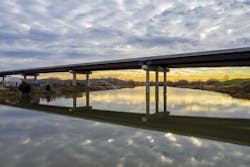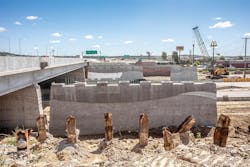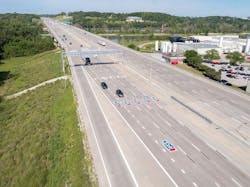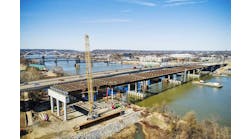Iowa’s $1.5 billion freeway reconstruction hits a major milestone with miles yet to go
By: Mark Pohlmann, P.E., PTOE, and Will Sharp, P.E., PTOE
The Iowa Department of Transportation (IDOT) hit a major milestone this spring with the opening of the dual, divided freeway in Council Bluffs. This design separates through traffic on I-80 from local traffic on I-29, creating I-80 express lanes and I-29/I-80 local lanes.
Part of the larger $1.5 billion Council Bluffs Interstate System Improvement Program, the dual, divided freeway is the marquee feature of a program that has been modernizing these major interstates for more than a dozen years.
The program, focused on the reconstruction of I-80, I-480, and I-29, is one of the largest efforts undertaken by IDOT. It includes 47 bridges, 12 interchanges, and 146 highway lane miles. When complete, it will improve capacity on a section of highway originally designed and completed in the 1950s and 1960s, bringing the roads up to modern design standards and improving safety for all drivers.
Construction began on the complex reconstruction of the interstate network in 2008 with the I-80 Missouri River bridge, connecting Council Bluffs to Omaha, Nebraska. Leveraging the success of this effort, in late 2013 the Iowa Transportation Commission committed to funding the program for the full build-out of all improvements.
That commitment coincided with a decision to pursue a programmatic approach to the complex effort, led by HDR, which has provided program management as well as design oversight and construction management. This approach was a first for IDOT and has been instrumental in keeping the program on schedule and on budget.
Scott Schram, District 4 Engineer for IDOT, oversees the program for the state. He said the sheer magnitude of the improvements made it clear that a programmatic approach was needed. Taking one project at a time would take too many years and would increase overall costs.
“It wasn’t just addressing one deficiency; it was a corridor approach,” Schram said. “If you’re going to reconstruct a corridor, it’s going to be a multiyear program. And you really can’t accomplish that without the program management piece.”
“It takes dedicated funding from the Iowa Transportation Commission to commit to the corridor,” Schram went on to explain. “And when you try to get buy-in from stakeholders such as the commission, you need to propose a budget, and you’ve got to be able to keep your promises and stick to it. That speaks to the programmatic funding side of things. And when you’re doing it not in a rural area but in an urban area, you have many more stakeholders and many more of the locals that are vested partners. The program manager piece really helps usher the entire project along, gaining buy-in every step of the way.”
Reduced Risk Through Packaged Projects
The programmatic approach showed its benefits right from the beginning, when the team took a fresh look at how the program was structured. The program was originally structured to include upward of 70 individual projects. However, through a series of design charrettes, a more efficient plan for maintenance of traffic with greatly reduced owner risk was developed, which combined key segments of work. Bundling together projects that could be constructed at the same time streamlined the construction schedule while reducing impacts to travelers. The size of construction packages was developed in coordination with the local contracting industry to ensure a competitive bidding environment.
As the program continued, this approach has also been valuable for its flexibility, said Schram. Depending on state funding or other priorities that shift from year to year, “we could take small projects and group them in one single package. And then we’ve also done the opposite, where we’ve taken a large package and divided it into smaller ones, to make room in the program for other priorities.”
Development Timed to Keep Program Moving
With so many individual projects, parts, and pieces, an early focus of the team was making sure that design development was timed to match the construction schedule. Keeping the entire program on schedule has required constant attention to what is coming next as well as what is currently being constructed. It takes time to develop final design plans for each project, particularly for some complex components that require approvals from multiple agencies, such as the U.S. Army Corps of Engineers or the Federal Railroad Administration. Understanding the lead time needed for these approvals and anticipating them has been vital to maintaining the overall program schedule.
It was important to involve design consultants and internal Iowa DOT design teams early to ensure that packages were ready when needed. As the program continued, the team learned from each previous package and applied those lessons to the next design package, reducing future risks to cost and schedule. The design development schedule meant walking a fine line of completing design in time to meet the construction schedule, while also leaving enough time to incorporate lessons from previous work.
More Accurate Construction Scheduling
In such a complex program, accurate and dependable construction scheduling is key to maintaining an overall schedule. This program was the first in the state to specify use of a robust critical path scheduling method for contractors, requiring them to commit to much more specific construction timelines. It offers the team more transparency into the schedule so that all involved understand the progression of work, any delays that are expected, and their causes. It also helps identify and plan for risks well ahead of time. Updated monthly, this method offers an early alert when expected schedules are not matching reality, allowing for proactive action to identify adjustments needed to get back on track sooner rather than later.
Comprehensive scheduling was also important because of the objective to award contracts to multiple contractors to help balance workloads.
“On typical projects, we wouldn’t make contractors submit very detailed scheduling,” Schram said, “but on a program this size, where schedule is very important and each contract depends on the one previous, the scheduling specification helps us track progress and make sure that our next package gets let on time because the other projects are on schedule.”
This approach is also beneficial for contractors. It means they can monitor the schedule with precision to prioritize work and resources to meet the contract requirements. They are better able to forecast resource needs, assess the impacts of delays from others, and minimize the duration of traffic impacts.
Understanding the construction schedule and developing a strong plan for its phases has helped reduce traffic impacts for those traveling through Council Bluffs. A concerted effort has been made to keep traffic moving during construction, not only providing lanes that were already there, but adding capacity as the program continues to serve the growing needs of the area in this long-term improvement. Traffic flow has been prioritized through a philosophy that once permanent capacity is added, it’s not taken away again—except perhaps for low-impact changes such as overnight closures, demonstrating continual improvement for travelers.
Success Built on Partnerships
Strong relationships with all partners including major contractors and prime consultants have been key to success. When the program began, many of those involved did not have much background with others, and there were a lot of unknowns. “We quickly learned we need to partner on challenges and face them together,” said Schram.
As work began, a concerted effort was made to build trust among the team. Regular construction partnership meetings began between high-level staff that included IDOT, HDR’s program management leadership, and prime construction contractors. Early in the program, the group met monthly or more often to work through higher-level issues that could impact the program, beyond day-to-day concerns. By creating that dialogue, the team got to know each other and developed a foundation of trust that has served the project well.
“Partnering was key to help transition through those early years and get to a point where we’re firing on all cylinders right now,” Schram said.
That relationship showed its value as projects moved through constructability reviews. Individual meetings with contractors produced workable solutions for difficult design challenges that were incorporated into final plans. The strong relationship with contractors has led to a better understanding among designers of what the contractors need and what challenges they are going to face in construction. That in turn has allowed designers to anticipate contractors’ needs and incorporate efficiencies in design packages.
Regular & Robust Program Updates
Getting updates to decision makers and stakeholders in real time has always been a top priority. A customized program management information system tracks program status, pulling cost, and schedule information from multiple databases to monitor the program’s overall performance. This information is compiled into a monthly report on the program, with updates on all costs separated by category—construction, right of way, utility relocation, engineering, or other concerns.
Proactive and regular communication with the public has also been emphasized throughout the program. Keeping residents apprised of the latest work and what to expect in the coming months is important to continued success. Working as an extension of IDOT staff, HDR puts out program updates and construction alerts through social media and email, monitors a phone hotline, creates graphical easy-to-understand annual reports that summarize program status, and briefs local elected officials on the program. The team strives every day to be the best source for timely and accurate information about the program and build upon the program’s slogan of “Getting You There.”
The statistics of the program speak to its size and complexity. Since construction began, the program has moved 9 million cubic yd of earthwork, poured 2 million sq ft of bridge deck, laid 99,000 ft of conduit and 82,500 ft of pipe, and completed 1.84 million sq yd of concrete paving.
Despite this monumental effort, the work has been made manageable and kept on schedule and budget through smart strategies that ensured everybody has a voice, everybody understands the project at hand, and that the overall program is flexible enough to pivot toward highest priorities. Multiple projects remain to be completed, including three major interchange reconstructions. But with the completion of the dual, divided freeway, the end is in sight, with the program 72% complete. And the lasting legacy for the community is a system that improves safety, reduces congestion, is upgraded to modern standards, and is built to last.
As Schram said of the program, “It brings progress. Community infrastructure is a sign of progress. And I think we’ve done that with this program.”
---------------
ABOUT THE AUTHOR:
Pohlmann has been working on the Council Bluffs program since early 2014, serving as design coordination manager, ITS services manager, deputy program manager, and has been HDR’s program manager since 2018. Sharp is HDR’s highways director and has been involved with the program since early alternatives analysis and environmental studies in 2000.








